Copyright Notice
Copyright 2017 LA PROVENCE
All Rights Reserved
You are not authorized to reproduce this title in any format and for any purpose. This title is published under Copyright protected terms and condition, of which its distribution and sales is strictly limited to the assigned Distributor/s and the Marketplace involved. You can only obtain a copy through legal source, and not to be tempered with any modification to it. Your understanding and compliance is appreciated.
First Printing: 2017.
Printed in the U.S.A
Publisher by LA PROVENCE PRINT .
17 rue du Marchal Foch CEDEX 1 Roubaix France.
Frances Nuclear Testing Programme
Algeria
France was the fourth nation to join the Nuclear Club when it successfully detonated a large nuclear device in Algeria in 1960. Over the next five years, France conducted 17 nuclear weapons tests at two locations in Algeria. Four were atmospheric tests and 13 were detonated underground.
A 2005 report published by the International Atomic Energy Agency describes the failure of an attempt to contain the Bryl test on 1 May 1962 on the north-east side of the test site at Taourirt Tan Afella. A spiral shaped tunnel which opened into the firing chamber had been designed to be closed off by the shock wave before the lava could reach the entrance of the tunnel. However, blocking of the main tunnel did not take place as planned. Between 5 and 10 percent of the test products activity escaped as lava, aerosols and gaseous products.
Arrangement of a tunnel used for weapon testing at Taourirt Tan Afella. (Photo courtesy of the IAEA. Radiological Conditions at the Former French Nuclear Test Sites in Algeria: Preliminary Assessment and Recommendations).
Tropical islands selected as location for nuclear teats
With Algerias independence in 1962, the French Defense Department started to look for alternative test sites. The uninhabited islands of Moruroa and Fangataufa in the South Pacific were chosen, with the main argument for the selection being that only 5,000 inhabitants lived within a 1,000 km radius of the proposed testing areas. However, the atoll of Tureia, with around 60 inhabitants, was only 100 km away from Moruroa and thus remained within the zone designated as dangerous.
France was not a signatory to the Partial Test Ban Treaty (PTBT) and established the Centre dexperimentation du Pacifique (CEP) at Moruroa in 1966. A total of 193 atmospheric and underground tests were conducted in the region over the next 30 years.
France was not a signatory to the Partial Test Ban Treaty (PTBT) and established the Centre dexperimentation du Pacifique (CEP) at Moruroa in 1966. A total of 193 atmospheric and underground tests were conducted in the region over the next 30 years.
General view (photograph taken in 1962) of the area contaminated by the Bryl test at Taourirt Tan Afella. (Photo courtesy of the IAEA. Radiological Conditions at the Former French Nuclear Test Sites in Algeria: Preliminary Assessment and Recommendations).
There have been several reported cases of rain-out i.e. fallout by rain formed by the particles of a nuclear explosion during the testing period. These cases are detailed in a report distributed by the International Physicians for the Prevention of Nuclear War (IPPNW) and the Institute for Energy and Environmental Research entitled Environmental Effects of French Nuclear Testing.
- One such incident occurred in Samoa, 3,610 km from Moruroa, on 12 September 1966. This was a consequence of the test Betelgeuse the previous day, in which a 120 kiloton bomb hanging under a balloon was exploded at a height of 600 metres in difficult wind conditions.
- After two tests within 17 days in 1966, radiation was measured on the nearby Gambier Islands at five times the permitted annual dose.
- The atoll of Tureia was affected during the test series of June/July 1967, when two French meteorologists on Tureia were evacuated two days after a test and transferred to hospital. A complete evacuation of Tureia took place in 1968.
- Another incident occurred at Tahiti on 19 July 1974, following a test of unknown yield and burst height a couple of days earlier. Radiation equivalent to the entire permitted annual dose was later measured in Tahiti.
Serious contamination to the environment
Environmental Effects of French Nuclear Testing details the environmental impact of the atmospheric tests in 1991. The total amount of plutonium-239 dispersed as a result of the 45 announced French atmospheric tests, including the four in Algeria, would be about 6750 curies, assuming 150 curies per test. On this basis, the amount of cesium-127 and strontium-90 dispersed into the atmosphere would have been 1.7 million curies and 1.1 million curies of strontium-90 [see Chart 1] respectively. About one half of the cesium and strontium remains in the atmosphere, on the ground, and in water bodies. French testing in the Pacific was the source of almost all the atmospheric fission product contamination, due to the much larger number of tests and the far greater yields of the French tests there than in Algeria
French nuclear bomb test at Mururoa Atoll, 1970.
Landslides, tsunamis and earthquakes caused by testing
From 1975, all nuclear blasts were carried out underground, causing both short-term and long-term environmental damage. At the time of the explosion, fracturing of the atoll surface triggered landslides, tsunamis and earthquakes. A report by the IPPNW and the Institute for Energy and Environmental Research on the Environmental Effects of French Nuclear Testing found evidence that radionuclides were vented into the environment. Possible long-term effects include leakage of fission products to the biosphere and transfer of dissolved plutonium from the lagoon to the ocean and the food chain. A number of scientific missions to Moruroa described severe impairment to the atoll. The damage included fissures in the limestone which are propagated by the testing, and surface subsidences of large areas of the atoll.
At least one major test-related landslide and consequent tsunami occurred in Moruroa on 25 July 1979. The report on the Environmental Effects of Nuclear Testing claims that a 120 kiloton weapon that was being tested, became stuck inside the shaft and could not be dislodged but was exploded anyway. The explosion resulted in a major underwater landslide of at least one million cubic metres of coral and rock and created a vast cavity. The underwater landslide produced a major tidal wave comparable to a tsunami, which spread through the Tuamotu Archipelago and injured people on the southern part of Moruroa.
Radionuclides detected in marine organisms
A mission in 1983 to Moruroa comprising scientists from Australia, New Zealand and Papua New Guinea identified unusual concentrations of iodine-131 (I-131) in marine organisms. Krypton-85 and tritium (see Chart 1) were also discovered in the air and water, indicating that venting had occurred. In 1987, a mission to the region by the scientist and researcher, Jacques Cousteau, found raised levels of I-131 in all sediment samples and plankton. Since I-131 has a short half life of 8.05 days, its presence could only be attributed to a recent emission.
The Australian, New Zealand and Papua New Guinea Mission to Moruroa in 1983 discovered that plutonium-239 concentrations in the air were about four times greater than in continental France.
Pristine marine environment used as nuclear dumping ground
The underground tests conducted at Moruroa turned it into a long-term waste dump, according to the IPPNW. Nuclear wastes existed under the atoll, without any of the ordinary safeguards that apply to a nuclear waste repository. The land area was also used to store radioactive waste (including metal scrap, wood, plastic bags and clothing) on the north coast of the atoll, which covers 30,000 square metres. In addition, a bomb broke apart on the surface of Moruroa on 21 July 1966, dispersing plutonium-239, which was confined to the area by fixing it in place with a layer of bitumen. Cyclones hit Moruroa in 1981, washing radioactive waste from the coral rim into the lagoon, including the plutonium-based bitumen.
Next page









